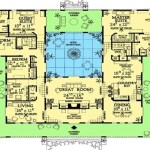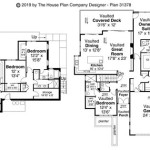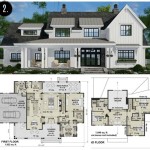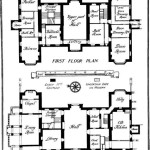Home Plans With Garage In Front: Considerations and Design Options
The design and placement of a garage are pivotal considerations in the architectural planning of a house. Garage placement influences curb appeal, functionality, and overall property value. Home plans featuring a garage in front are a common choice, offering convenience and sometimes cost-effectiveness, but they also present unique design challenges and considerations. This article will explore the various aspects of home plans with a garage in front, including their benefits, drawbacks, design options, and factors to consider during the planning process.
Advantages and Disadvantages of Front-Facing Garages
Front-facing garages offer several advantages. Primary among these is convenience. The direct access to the home from the garage simplifies unloading groceries, moving items, and entering the house during inclement weather. This is especially valuable for individuals with mobility issues or families with young children. Often, front-facing garages are more economical to build. Because they are typically integrated into the main structure of the house, they might require less foundation work and fewer exterior walls compared to detached or side-entry garages. This integration can also simplify utility connections.
However, front-facing garages also present several disadvantages. The most significant drawback is the potential to diminish curb appeal. A large garage door dominating the front façade can detract from the architectural aesthetics of the house, making it appear less visually appealing and more utilitarian. Such designs, if not carefully executed, can reduce the home's market value relative to homes with more aesthetically pleasing garage placements. Front-facing garages can also limit the amount of front yard space available. Depending on the size of the garage and the setback requirements, the garage might occupy a significant portion of the lot's frontage, leaving less room for landscaping, gardens, or other desirable features. Furthermore, front-facing garages often result in noise pollution within the home, particularly if the garage door opener is loud or if the garage is used for mechanical work. This can affect the comfort and tranquility of living spaces, especially those located near the garage.
Design Strategies for Enhancing Curb Appeal
Mitigating the negative impact of a front-facing garage on curb appeal requires careful planning and design strategies. One effective approach is to minimize the visual prominence of the garage door. This can be achieved by choosing garage doors that blend seamlessly with the overall architectural style of the house. Opting for doors with windows, decorative hardware, or custom finishes can enhance their appearance and make them less obtrusive. Incorporating architectural details that complement the garage door, such as matching trim, siding, or stonework, can further integrate the garage into the overall design. Another strategy is to break up the mass of the garage visually. This can be accomplished by using different materials or textures on the garage façade or by adding architectural elements such as pilasters, columns, or arches. These features can add visual interest and depth, making the garage appear less monolithic.
Landscaping plays a crucial role in enhancing the curb appeal of homes with front-facing garages. Planting trees, shrubs, and flowers around the garage can soften its appearance and create a more welcoming entry. Trellises with climbing plants can be used to screen the garage walls and add vertical interest. Well-placed lighting can also enhance the visual appeal of the garage and create a more inviting atmosphere at night. Consider using accent lighting to highlight architectural details or landscaping features around the garage. The driveway design also influences the overall curb appeal. Instead of a plain concrete driveway, consider using pavers, stamped concrete, or other decorative materials to add visual interest. Incorporating curves or patterns into the driveway design can also help to break up the monotony of a long, straight driveway leading to the garage.
Careful color selection can significantly impact the visual impact of a front-facing garage. Avoid painting the garage door a bright or contrasting color that will draw attention to it. Instead, choose colors that blend with the overall color scheme of the house or that complement the surrounding landscape. Using multiple colors or shades on the garage façade can also help to break up the mass and add visual interest. Attention to these details will contribute to a more cohesive and aesthetically pleasing design.
Floor Plan Considerations and Functional Design
When designing a home with a front-facing garage, careful attention must be paid to the floor plan to maximize functionality and minimize potential drawbacks. One key consideration is the placement of living spaces relative to the garage. Ideally, living rooms, bedrooms, and other quiet areas should be located away from the garage to minimize noise and disturbance. Entry points from the garage into the house should be strategically located to provide convenient access without disrupting the flow of traffic. A mudroom or entryway with storage space is often a desirable feature, providing a place to store shoes, coats, and other items before entering the main living areas. The interior layout of the garage itself should also be carefully planned. Consider the intended use of the garage, whether it is primarily for parking vehicles or also for storage, workshop space, or other activities. Adequate storage space, shelving, and workbenches can help to keep the garage organized and functional. Good lighting is essential for safety and visibility, especially at night.
The size and configuration of the garage should be carefully considered in relation to the overall size and design of the house. A garage that is too large or too small can detract from the overall aesthetic appeal and functionality. A two-car garage is a common choice for many homes, but larger families or those with multiple vehicles might require a three-car garage or even a tandem garage. The dimensions of the garage should be sufficient to accommodate the vehicles being parked, as well as any additional storage or workspace. The garage door size and type should also be carefully selected. Overhead doors are the most common type of garage door, but other options such as roll-up doors or side-hinged doors might be more suitable for certain applications. The garage door opener should be reliable and quiet to minimize noise and disturbance.
Incorporating universal design principles into the garage design can also enhance its accessibility and functionality. Consider features such as wider doorways, ramps instead of steps, and easily operable door handles. These features can make the garage more accessible for individuals with mobility issues or those who are aging in place. In addition, consider the placement of electrical outlets and lighting fixtures to ensure that the garage is well-lit and easily accessible for various tasks. The placement of water spigots and drainage systems should also be considered to facilitate washing vehicles or cleaning the garage floor. Thoughtful planning and design can transform a front-facing garage from a utilitarian space into a functional and aesthetically pleasing component of the home.
Construction Materials and Sustainability
The choice of construction materials for a front-facing garage can significantly impact its durability, aesthetics, and environmental impact. Common materials for garage construction include wood framing, concrete block, and pre-engineered steel. Wood framing is a versatile and cost-effective option, but it is susceptible to rot and insect damage if not properly treated. Concrete block is a durable and fire-resistant option, but it can be more expensive than wood framing. Pre-engineered steel is a strong and durable option that is often used for commercial garages, but it can be less aesthetically pleasing than wood or concrete block.
The choice of roofing materials for the garage should also be carefully considered. Asphalt shingles are a common and economical option, but they have a relatively short lifespan. Metal roofing is a more durable and long-lasting option, but it can be more expensive. Tile roofing is another option that is both durable and aesthetically pleasing, but it is also more expensive. The color and style of the roofing materials should complement the overall design of the house.
Sustainable building practices can be incorporated into the construction of a front-facing garage to reduce its environmental impact. Consider using recycled or reclaimed materials whenever possible. Install energy-efficient lighting fixtures and appliances. Insulate the garage walls and ceiling to reduce energy consumption. Install a rainwater harvesting system to collect rainwater for irrigation or other non-potable uses. Consider using permeable paving materials for the driveway to reduce stormwater runoff. By incorporating these sustainable building practices, it is possible to construct a front-facing garage that is both functional and environmentally responsible.

20 Luxury Narrow House Plans With Front Garage Images Small Traditional Plan

Contemporary Two Story House Plan 1974

House Plan 3 Bedrooms 2 5 Bathrooms Garage 3877 V1 Drummond Plans

Plenty Of Storage Our Favorite 3 Car Garage House Plans Houseplans Blog Com

12 Simple 2 Bedroom House Plans With Garages Houseplans Blog Com

Country Two Story House Plan 1352 The Turningdale

House Plan 3 Bedrooms 1 5 Bathrooms Garage 3876 V2 Drummond Plans

Garage In Front Of House Plans 85 Two Floor Modern Ideas 6 Bedroom
European Style House Plan 4 Beds 3 Baths 2195 Sq Ft 929 958 Builderhouseplans Com
1400 Sq Ft Country House Plan 3 Bedroom Bath Garage








